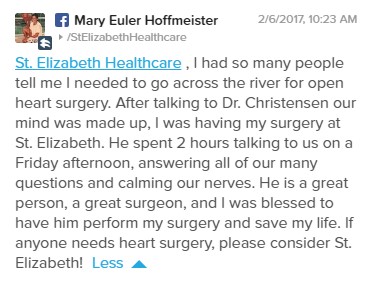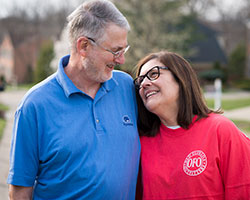Mary Hoffmeister
Retired police officer has rare tumor removed from inside her heart
One night, as Mary Hoffmeister was getting ready for bed, she took off her socks and saw something that caught her completely off guard.
“Both my ankles were swollen; they were huge!” remembers Mary. Her ankles were so swollen that her socks left deep ridges in the skin.
“I didn’t know what was going on,” says Mary. “It scared me.”
Mary is a retired police officer, and she lives in Florence with her husband, Jim. At 59, not much surprises her anymore. But her swollen ankles were so unusual and so sudden, she went to her primary care doctor the very next day.
Mary’s decision to take action may have saved her life.
A stunning diagnosis
When you have swollen ankles, it does not necessarily mean you have a serious medical problem. Often, the culprit is a food, drink or fatigue from standing or walking.
As a precaution, Mary’s primary care provider referred her for an echocardiogram, a diagnostic test that takes a picture of the heart.
The news was not good. The echo showed a spot on Mary’s heart, and the doctor said it could be a tumor.
“I was shocked,” remembers Mary. “I said, ‘A tumor? On my heart?’ And the doctor said, ‘No, INSIDE your heart.’”
Further tests revealed that the spot was a myxoma, a rare tumor that grows inside the heart, and she would need open heart surgery to remove it.
“I thought, ‘This can’t be. I’m a healthy girl. I don’t get sick,’” remembers Mary. “I can’t die. I have a husband and two daughters.”
“It was like a nightmare,” says Jim. “I had never heard of such a thing.”
Searching for the very best heart care
Mary’s family wanted her to have the best care available for her open heart surgery. Initially, friends encouraged her to seek care over the river.
Mary decided to consult first with Dr. George Christensen, a Cardiac and Thoracic Surgeon, with the St. Elizabeth Heart & Vascular Institute.
“My nurses spoke highly of Dr. Christensen,” says Mary.
Scared and still in shock about her heart tumor, Mary and Jim met with
Dr. Christensen to find out what she was facing.
“Mary’s myxoma was attached to the septal wall in the left atrium, which is in the upper section of the heart,” says Dr. Christensen.
Her tumor was very loosely attached, at risk of escaping into the bloodstream.
“My concern, for example, was that a piece of the tumor would detach and travel to the brain causing a stroke,” explained Dr. Christensen. “Or it could potentially enlarge and a blood clot could form over the tumor, causing a blockage downstream. So we needed to remove it very soon.”
Dr. Christensen talked with the Hoffmeisters for nearly two hours.
“He took his time with us,” says Mary. “We had a lot of questions.”
“He made sure we understood what was happening,” says Jim. “We were not rushed.”
Dr. Christensen believes that it is important to take time with patients who are trying to make serious decisions about their medical care.
“Mary had a very complex situation to resolve,” says Dr. Christensen. “I explained the benefits, the risks and the alternatives. This is someone’s life, and she is someone’s loved one. For my mom, my aunt or my sister, I would expect the same type of care.”
After their consultation, Mary said there was no question about it. “My surgery was going to be done at St. Elizabeth.”
Open heart surgery at St. Elizabeth Healthcare
After a new round of tests to make sure Mary had no other issues with her heart, Dr. Christensen and his colleagues at St. Elizabeth performed open heart surgery to remove Mary’s tumor.
Her treatment involved cardiopulmonary bypass. She was placed on a heart-lung machine, which substitutes for the heart and lungs during surgery.
“In essence, we silenced and cooled the heart. When we do this, the heart receives much less blood allowing us to see the interior structures of the heart more clearly,” explains Dr. Christensen. “From there, we opened the left atrial chamber to identify the lesion. We gently removed the tumor and sent it to pathologists.”
During surgery, Dr. Christensen actually discovered a second growth hidden behind the initial tumor and removed that too.
“Throughout the operation, they kept our family fully informed,” says Jim. “We absolutely appreciated it.”
Thankfully, lab results showed that Mary’s tumors were a benign type called atrial myxomas. She would not need chemotherapy or radiation.
“It was a huge relief when we got that news,” says Mary.
Mary raves about her experience at St. Elizabeth, even on Facebook.

Meanwhile, Mary is glad she didn’t ignore those swollen ankles. And she’s glad she chose St. Elizabeth.
“There’s not a day that goes by that I don’t think about Dr. Christensen and all the nurses who took care of me,” says Mary. “They saved my life.”

For more information about Heart & Lung Surgery at the St. Elizabeth Heart & Vascular Institute, click here.

